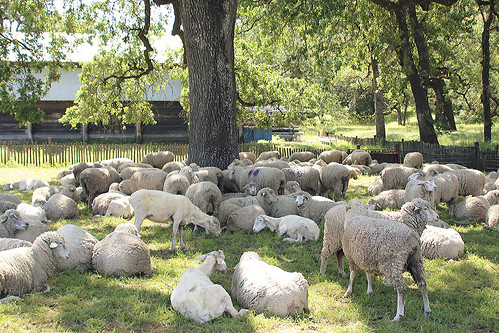
USDA’s National Institute of Food and Agriculture (NIFA) administers the Smith-Lever capacity grant program. The Smith–Lever Act established the cooperative extension services program administered through land-grant universities. Today, a guest blog from Jeanette Warnert, University of California Division of Agriculture and Natural Resources, tells us how this program supports a unique rural economic opportunity:
Sheep shearing is like a dance. It requires strength, flexibility, a tender touch, and the right moves. Once mastered, the skill can open the door to gratifying and high-paying seasonal work.
Sheep shearers will never be unemployed and never be poor. They can earn $50 to $100 per hour and can start a business with a $3,000 investment in equipment, says John Harper, University of California Cooperative Extension (UCCE) natural resources advisor in Mendocino County.
The need for skilled sheep shearers in California and other parts of the nation has prompted the University of California Hopland Research and Extension Center to host an annual sheep shearing school, the only intensive five-day course in the United States. Harper, the lead instructor and coordinator of sheep shearing school, is a 25-year veteran of UCCE. USDA’s National Institute of Food and Agriculture (NIFA) funds the program through a Smith-Lever capacity grant.
Although sheep shearing is traditionally a male occupation, women are also encouraged to take the course. In this low-to-the-ground endeavor, women have the advantage of a lower center of gravity. Strength is important, but so is the shearer’s flexibility, especially hip rotation. The sheep’s skin is very loose and the blades are powerful. Harper said the female students tend to be more cautious, which results in fewer nicks.
Beatrice Thomas, 41, is a typical student. A dancer, she left her Bay Area office job a year ago because, after sitting for 40 hours at a desk, her body ached. The finesse and physical work of sheep shearing, on the other hand, left her feeling vital.
The 5,200-acre Hopland Research and Extension Center is home to a flock of about 1,000 sheep, which provide opportunities for scientists to study their role in land management. They also serve as a ready supply of animals for prospective new shearers to learn the craft.
The instructors say learning to handle sheep calmly is the key to shearing success. Learning the finer points of shearing – footwork, positions, and getting the pattern down – come with practice.
The week-long sheep shearing school at Hopland are held in the spring. The class typically fills up within two hours of opening registration. Visit the UCCE Mendocino website for more information or to be notified when the next registration opens.
